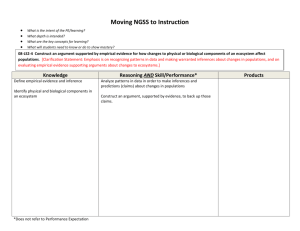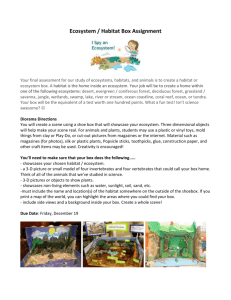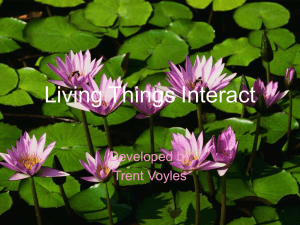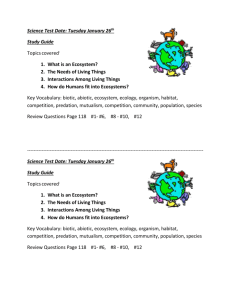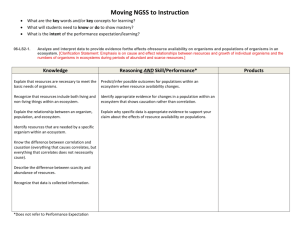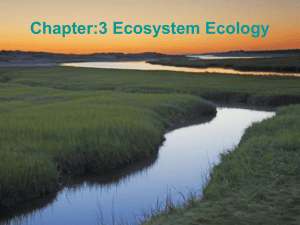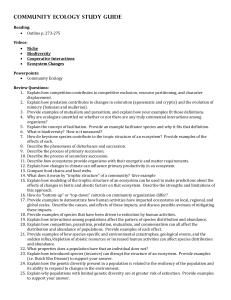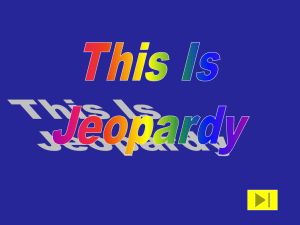Science Monday
advertisement
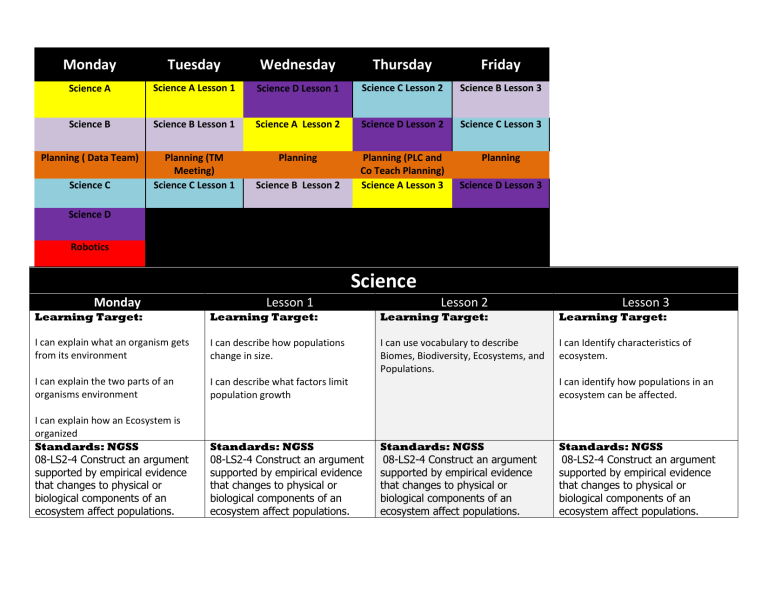
Monday Tuesday Wednesday Thursday Friday Science A Science A Lesson 1 Science D Lesson 1 Science C Lesson 2 Science B Lesson 3 Science B Science B Lesson 1 Science A Lesson 2 Science D Lesson 2 Science C Lesson 3 Planning ( Data Team) Planning (TM Meeting) Science C Lesson 1 Planning Planning (PLC and Co Teach Planning) Science A Lesson 3 Planning Science C Science B Lesson 2 Science D Lesson 3 Science D Robotics Science Lesson 2 Lesson 3 Learning Target: Monday Learning Target: Lesson 1 Learning Target: Learning Target: I can explain what an organism gets from its environment I can describe how populations change in size. I can use vocabulary to describe Biomes, Biodiversity, Ecosystems, and Populations. I can Identify characteristics of ecosystem. I can explain the two parts of an organisms environment I can describe what factors limit population growth I can explain how an Ecosystem is organized Standards: NGSS 08-LS2-4 Construct an argument supported by empirical evidence that changes to physical or biological components of an ecosystem affect populations. Standards: NGSS 08-LS2-4 Construct an argument supported by empirical evidence that changes to physical or biological components of an ecosystem affect populations. I can identify how populations in an ecosystem can be affected. Standards: NGSS 08-LS2-4 Construct an argument supported by empirical evidence that changes to physical or biological components of an ecosystem affect populations. Standards: NGSS 08-LS2-4 Construct an argument supported by empirical evidence that changes to physical or biological components of an ecosystem affect populations. Instructional Method Instructional Method Instructional Method Instructional Method Students will read about living things in an ecosystem. Student will read about populations in ecosystems. Bellringer: Bellringer: Students will list 4 levels of an ecosystem from smallest to largest Students will list two ways populations increase and two ways they decrease Students will Identify questions they had from the practice quiz they received the day before. Students will complete a vocabulary practice worksheet Students will analyze data on squirrel population over time and answer questions. Students have had a substitute and will need to do a self-evaluation on where they are at compared to where they should be. They will be asked to fill out a checklist and self-evaluate their performance while I was gone. Students will analyze a picture and apply the vocab and concepts of ecosystem and habitat to the picture Students will make their own graphs of bacteria population over time and analyze the information. Students will take a practice quiz Students will take a practice quiz Craft: Do a quick vocabulary questionnaire using the plickers Show results Discuss vocabulary workshop Workshop: Each group will have 18 flash cards and divide 18 words up to create flashcards for all the vocab words. The students will play a vocabulary game where there is a holder, answer, a data keeper, and counter. The holder will pick 10 random cards and ask the answerer. The holder will say the definition and the answerer will try and say the word. The counter will count down from 5 seconds for the answerer to answer each definition (they will start the count down after the definition has been given). The answer cannot answer until after the definition has been given. The data keeper will keep track of how many points each group member has. Expand the game by doing all 18 cards Craft: Practice any questions the students had fro practice quiz. Workshop: Take assessment on Biomes, Biodiversity, Ecosystems, and Populations Finish taking Graphing Test ( or start graphing test) Reflection: Students will choose to write a quick reflection on words they once did not know but know now Assessment quiz over vocabulary Instructional Strategies: Instructional Strategies: Instructional Strategies: Instructional Strategies: direct instruction, journaling, reading and writing strategies direct instruction, journaling, reading and writing strategies Pair work, direct instruction, workshop group work Independent work Vocabulary: Organism, habitat, biotic, abiotic, specie, community, ecosystem, ecology, population Vocabulary: Vocabulary: Vocabulary: Birth rate, death rate, immigration, emigration, population density, limiting factor, carrying capacity Biome, Biodiversity, Keystone species, Extinction, Endangered Species, Threatened Species, Habitat Destruction, Habitat Fragmentation, Poaching, Captive Breeding, Abiotic Factor, Biotic Factor, Ecology, Population, Birth Rate , Death Rate, Limiting Factor, Carrying Capacity Assessment: 1. Vocabulary Identification 2. Vocabulary application 3. Analyzing a picture to show they can identify smallest unit of organization Assessment: Assessment: 1. Vocabulary Identification 2. Vocabulary application 1. 2. Explain why two different species in an ecosystem can share the same habitat but not the same niche. Analyzing data on population of species in a given habitat Assessment: 1. Vocabulary Identification 2. Vocabulary application 3. Analyzing a picture to show they can identify smallest unit of organization 4. Explain why two different species in an ecosystem can share the same habitat but not the same niche. 5. Analyzing data on population of species in a given habitat Resources: Resources: Resources: Resources: Homework: Homework: Homework: Homework: None None None None Differentiated: Differentiated:. Differentiated: Differentiated: C block collaboration: 1. Grouping, prompting and cueing, graphic oragizers (edgenuity ecosystem C block collaboration: 1. Grouping, prompting and cueing, graphic oragizers 2. (edgenuity ecosystem) 3. Pull out groups for mini lab on population using beans C block collaboration: 1. Grouping, prompting and cueing, graphic oragizers (edgenuity ecosystem C block collaboration: 1. Grouping, prompting and cueing, graphic oragizers (edgenuity ecosystem SGG Items SGG Items: SGG Items Test will be read to them on Ipod SGG Items: Finish initial test Robotics:
